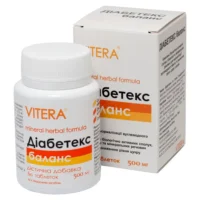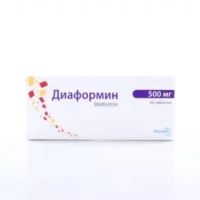Description
Duglimax (Metformin Hydrochloride) Tablets 500 mg/1 mg. №60
Ingredients
Active Ingredient: Metformin hydrochloride
Other ingredients: microcrystalline cellulose, povidone, magnesium stearate, hypromellose, titanium dioxide, polyethylene glycol.
Mechanism of Action
Metformin hydrochloride, the primary component of Duglimax tablets, acts by decreasing hepatic glucose production and enhancing peripheral glucose uptake. This dual mechanism leads to improved insulin sensitivity in the body.
Pharmacological Properties
Duglimax tablets belong to the biguanide class of drugs and are recognized for their efficacy in reducing hepatic glucose output, thereby lowering blood sugar levels. Additionally, they promote peripheral glucose utilization, further aiding in glycemic control.
Indications for Use
Duglimax tablets are indicated as an adjunct to diet and exercise to enhance glycemic control in adults diagnosed with type 2 diabetes mellitus.
Contraindications
Avoid using Duglimax if you have severe kidney disease or metabolic acidosis. It is advisable to seek medical advice before initiating treatment if you are pregnant or breastfeeding.
Side Effects
Common side effects of Duglimax may include gastrointestinal disturbances such as nausea, vomiting, or diarrhea. In rare cases, lactic acidosis can occur, especially in individuals with predisposing conditions.
Usage Instructions
The typical dosage of Duglimax is 500 mg once daily with the evening meal. Dosage adjustments should be made based on individual requirements and under healthcare provider supervision.
Benefits Compared to Analogues
Duglimax offers superior efficacy in enhancing insulin sensitivity and lowering blood glucose levels compared to many other antidiabetic medications. Its safety profile and proven cardiovascular benefits make it a preferred choice in diabetes management.
Suitable Patient Groups
Duglimax is suitable for adult patients with type 2 diabetes mellitus. Dosage adjustments may be necessary for elderly individuals or those with hepatic impairment, guided by a healthcare professional.
Storage and Shelf Life
Store Duglimax tablets in a cool, dry place away from direct sunlight. Ensure proper sealing of the packaging to protect from moisture. Check the expiration date and do not use expired medication.
Packaging Description
Duglimax tablets are typically packaged in blister packs of 60 tablets each. The packaging is designed to maintain the stability and integrity of the tablets until use.
Scientific Evidence
Metformin, the active ingredient in Duglimax, has been extensively studied for its role in diabetes management. Clinical trials have demonstrated its efficacy in improving glycemic control and reducing the risk of cardiovascular complications associated with diabetes.
Clinical Studies
Research published in reputable journals such as the New England Journal of Medicine has highlighted the cardiovascular benefits of metformin therapy. Studies have shown that metformin not only lowers blood glucose levels but also contributes to overall cardiovascular health in diabetic patients.
Additional Information
Regular monitoring of blood sugar levels is crucial while taking Duglimax to ensure optimal control. Any changes in health status or medication regimen should be promptly communicated to your healthcare provider for appropriate management.





